The MacBook Pro Review (13 & 15-inch): 2011 Brings Sandy Bridge
by Anand Lal Shimpi, Brian Klug & Vivek Gowri on March 10, 2011 4:17 PM EST- Posted in
- Laptops
- Mac
- Apple
- Intel
- MacBook Pro
- Sandy Bridge
Turbo and the 15-inch MacBook Pro
The 15 and 13 are different enough that I'll address the two separately. Both are huge steps forward compared to their predecessors, but for completely different reasons. Let's start with the 15.
Starting with Sandy Bridge, all 15 and 17-inch MacBook Pros now feature quad-core CPUs. This is a huge deal. Unlike other notebook OEMs, Apple tends to be a one-size-fits-all sort of company. Sure you get choice of screen size, but the options dwindle significantly once you've decided how big of a notebook you want. For the 15 and 17-inch MBPs, all you get are quad-core CPUs. Don't need four cores? Doesn't matter, you're getting them anyway
| Evolution of the 15-inch MacBook Pro | Early 2011 | Mid 2010 | Late 2009 |
| CPU | Intel Core i7 2.0GHz (QC) | Intel Core i5 2.40GHz (DC) | Intel Core 2 Duo 2.53GHz (DC) |
| Memory | 4GB DDR3-1333 | 4GB DDR3-1066 | 4GB DDR3-1066 |
| HDD | 500GB 5400RPM | 320GB 5400RPM | 250GB 5400RPM |
| Video | Intel HD 3000 + AMD Radeon HD 6490M (256MB) |
Intel HD Graphics + NVIDIA GeForce GT 330M (256MB) |
NVIDIA GeForce 9400M (integrated) |
| Optical Drive | 8X Slot Load DL DVD +/-R | 8X Slot Load DL DVD +/-R | 8X Slot Load DL DVD +/-R |
| Screen Resolution | 1440 x 900 | 1440 x 900 | 1440 x 900 |
| USB | 2 | 2 | 2 |
| SD Card Reader | Yes | Yes | Yes |
| FireWire 800 | 1 | 1 | 1 |
| ExpressCard/34 | No | No | No |
| Battery | 77.5Wh | 77.5Wh | 73Wh |
| Dimensions (W x D x H) | 14.35" x 9.82" x 0.95" | 14.35" x 9.82" x 0.95" | 14.35" x 9.82" x 0.95" |
| Weight | 5.6 lbs | 5.6 lbs | 5.5 lbs |
| Price | $1799 | $1799 | $1699 |
Apple was able to rationalize this decision because of one feature: Intel Turbo Boost.
In the ramp to 90nm Intel realized that it was expending a great deal of power in the form of leakage current. You may have heard transistors referred to as digital switches. Turn them on and current flows, turn them off and current stops flowing. The reality is that even when transistors are off, some current may still flow. This is known as leakage current and it becomes a bigger problem the smaller your transistors become.

With Nehalem Intel introduced a new type of transistor into its architecture: the power gate transistor. Put one of these babies in front of the source voltage to a large group of transistors and at the flip of a, err, switch you can completely shut off power to those transistors. No current going to the transistors means effectively no leakage current.
Prior to Intel's use of power gating, we had the next best thing: clock gating. Instead of cutting power to a group of transistors, you'd cut the clock signal. With no clock signal, any clocked transistors would effectively be idle. Any blocks that are clock gated consume no active power, however it doesn't address the issue of leakage power. So while clock gating got you some thermal headroom, it became less efficient as we moved to smaller and smaller transistors.
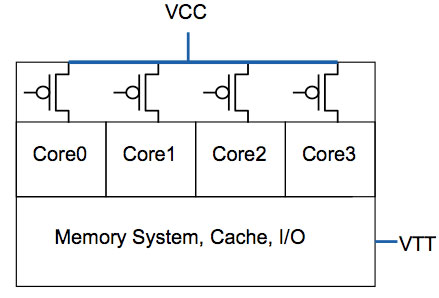
All four cores in this case have the same source voltage, but can be turned off individually thanks to the power gate above the core
Power gating gave Intel one very important feature: the ability to truly shut off a core when not in use. Prior to power gating Intel, like any other microprocessor company, had to make tradeoffs in choosing core count vs. clock speed. The maximum power consumption/thermal output is effectively a fixed value, physics has something to do with that. If you want four cores in the same thermal envelope as two cores, you have to clock them lower. In the pre-Nehalem days you had to choose between two faster cores or four slower cores, there was no option for people who needed both.
Now, with the ability to mostly turn off idle cores, you can get around that problem. A fully loaded four core CPU will still run at a lower clock than a dual core version, however with power gating if you are only using two cores then you have the thermal headroom to ramp up the clock speed of the two active cores (since the idle ones are effectively off).

Get a little more clever and you can do this power gate and clock up dance for more configurations. Only using one core? Power gate three and run the single active core at a really really high speed. All of this is done by a very complex piece of circuitry on the microprocessor die. Intel introduced it in Nehalem and called it the Power Control Unit (this is why engineers aren't good marketers but great truth tellers). The PCU in Nehalem was about a million transistors, around the complexity of the old Intel 486, and all it did was look at processor load, temperature, power consumption, active cores and clock speed. Based on all of these inputs it would determine what to turn off and what clock speed to run the entire chip at.
Another interesting side effect of the PCU is that if you're using all cores but they're not using the most power hungry parts of their circuitry (e.g. not running a bunch of floating point workloads) the PCU could keep all four active but run them at a slightly higher frequency.
| Single Core | Dual Core | Quad Core | |
| TDP |
 |
 |
 |
| Tradeoff |
 |
 |
 |
The PCU actually works very quickly. Let's say you're running an application that only for a very brief period is only using a single core. That's more than enough time for the PMU to turn off all unused cores, turbo up the single core and complete the task quicker.
Intel calls this dynamic frequency scaling Turbo Boost (ah this is where the marketing folks took over). The reason I went through this lengthy explanation of Turbo is because it allowed Apple to equip the 15-inch Macbook Pro with only quad-core options and not worry about it being slower than the dual-core 13-inch offering, despite having a lower base clock speed (2.0GHz for the 15 vs. 2.3GHz for the 13).
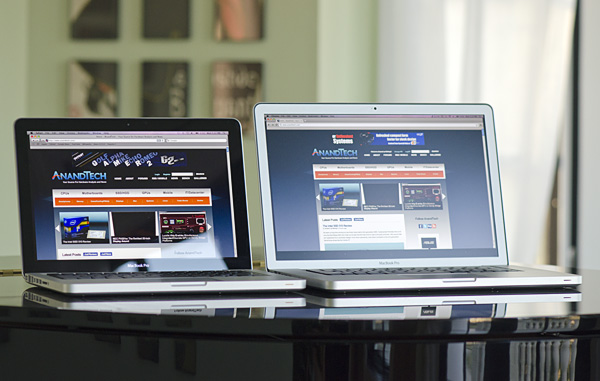
13-inch MacBook Pro (left), 15-inch MacBook Pro with optional high res/anti-glare display (right)
Apple offers three CPU options in the 15-inch MacBook Pro: a 2.0GHz, 2.2GHz or 2.3GHz quad-core Core i7. These actually correspond to the Core i7-2635QM, 2720QM and 2820QM. The main differences are in the table below:
| Apple 15-inch 2011 MacBook Pro CPU Comparison | |||||
| 2.0GHz quad-core | 2.2GHz quad-core | 2.3GHz quad-core | |||
| Intel Model | Core i7-2635QM | Intel Core i7-2720QM | Intel Core i7-2820QM | ||
| Base Clock Speed | 2.0GHz | 2.2GHz | 2.3GHz | ||
| Max SC Turbo | 2.9GHz | 3.3GHz | 3.4GHz | ||
| Max DC Turbo | 2.8GHz | 3.2GHz | 3.3GHz | ||
| Max QC Turbo | 2.6GHz | 3.0GHz | 3.1GHz | ||
| L3 Cache | 6MB | 6MB | 8MB | ||
| AES-NI | No | Yes | Yes | ||
| VT-x | Yes | Yes | Yes | ||
| VT-d | No | Yes | Yes | ||
| TDP | 45W | 45W | 45W | ||
The most annoying part of all of this is that the base 2635 doesn't support Intel's AES-NI. Apple still doesn't use AES-NI anywhere in its OS it seems so until Lion rolls around I guess this won't be an issue. Shame on Apple for not supporting AES-NI and shame on Intel for using it as a differentiating feature between parts. The AES instructions, introduced in Westmere, are particularly useful in accelerating full disk encryption as we've seen under Windows 7.
Note that all of these chips carry a 45W TDP, that's up from 35W in the 13-inch and last year's 15-inch model. We're talking about nearly a billion transistors fabbed on Intel's 32nm process—that's almost double the transistor count of the Arrandale chips found in last year's MacBook Pro. These things are going to consume more power.
Despite the fairly low base clock speeds, these CPUs can turbo up to pretty high values depending on how many cores are active. The base 2.0GHz quad-core is only good for up to 2.9GHz on paper, while the 2720QM and 2820QM can hit 3.3GHz and 3.4GHz, respectively.
Given Apple's history of throttling CPUs and not telling anyone I was extra paranoid in finding out if any funny business was going on with the new MacBook Pros. Unfortunately there are very few ways of measuring turbo frequency under OS X. Ryan Smith pointed me in the direction of MSR Tools which, although not perfect, does give you an indication of what clock speed your CPU is running at.
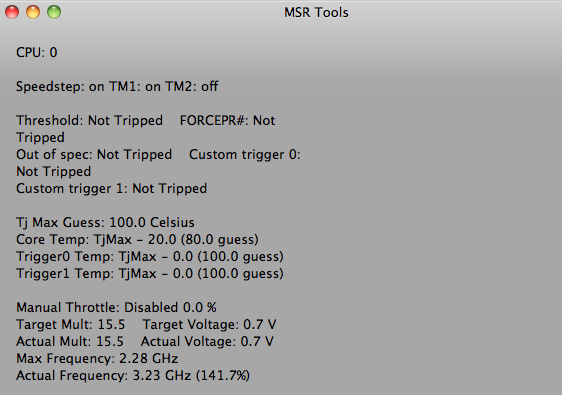
Max single core turbo on the 2.3GHz quad-core
With only a single thread active the 2.3GHz quad-core seemed to peak at ~3.1—3.3GHz. This is slightly lower than what I saw under Windows (3.3—3.4GHz pretty consistently running Cinebench R10 1CPU test). Apple does do power management differently under OS X, however I'm not entirely sure that the MSR Tools application is reporting frequency as quickly as Intel's utilities under Windows 7.
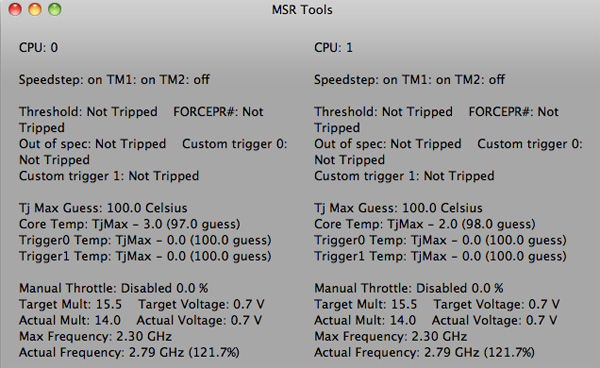
Max QC turbo on the 2.3GHz quad-core
With all cores active (once again, Cinebench R10 XCPU) the max I saw on the 2.3 was 2.8GHz. Under Windows running the same test I saw similar results at 2.9GHz.
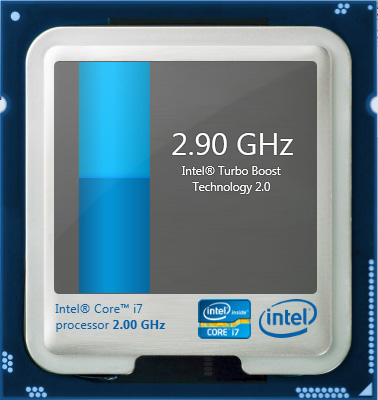
Max QC turbo on the 2.3GHz quad-core under Windows 7
I'm pretty confident that Apple isn't doing anything dramatic with clock speeds on these new MacBook Pros. Mac OS X may be more aggressive with power management than Windows, but max clock speed remains untouched.
| Mac OS X 10.6.6 vs. Windows 7 Performance | ||||
| 15-inch 2011 MBP, 2.0GHz quad-core | Single-Threaded | Multi-Threaded | ||
| Mac OS X 10.6.6 | 4060 | 15249 | ||
| Windows 7 x64 | 4530 | 16931 | ||
Note that even though the operating frequencies are similar under OS X and Windows 7, Cinebench performance is still higher under Windows 7. It looks like there's still some software optimization that needs to be done under OS X.











198 Comments
View All Comments
dqnet - Wednesday, March 16, 2011 - link
I'm really considering splashing out on the 13" but I've read countless articles and all I hear is the glossy screen is either horrible or awful. I don’t want the 15", I need the portability and I don’t know what on earth to do!??????????Then comes the SSD issue, if I want this option I have to wait 6 weeks!
I can always get this later down the line I guess?? Well from what the article suggests??
Any help (opinions) would be great as right now I’m lost! :(
Mac Ike - Wednesday, March 16, 2011 - link
If a person bought a MacBook Pro in the last 18-24 months,I don't see the reason to upgrade unless you're on the Bleeding-edge of performance needs and Mac your living with your Mac. Many Apps and advanced Software aren't even optimized to take advantage of multiple Cores,or Hyper-Threading/Turbo Boost. I don't care as much for Auto Switching Graphics,since I have total control of my Graphics with my March 2010 MacBook Pro 17"/Core 2 Duo/2.8 Ghz/4GB RAM/AG/500GB HD/512MB or 256(IG) VRAM-dual cards/express card. if I was buying new today,Hyper-Threading and Turbo Boost schemes would be OK,but there's no way that I'd trade or sell my machine for these updates! To me,speed hasn't been an issue in 2 or 3 years! My 2006 20" iMac was at 2.0 Ghz,and the newest Macs are 2.0-3.0Ghz or so. I know that Sandy Bridge is faster than a Merom Core Duo,but most improvements seem to have come from adding more Cores and RAM,so that more tasks can be done simultaneously! I don't care for gimmicks,Turbo-Boosting,Hyper-Threading,and poorer graphics to convince me to upgrade my Macs. Unless you are a Digital Video Content Creator,or other high-powered user,or your Mac is 3 yrs. Old or so,you should Max-out your RAM,get a faster HDD or an SSD,rather than buying a Whole New Mac! If you have the money to spend,good for you,but a combination of Power,Battery-Life,and Portability,are the REAL issues! I wish people would stop telling others that they're Idiots for paying Mac prices,since it's our Money,and only YOU can determine what's good value for the Performance,elegance,and Stability of Apple Hardware!rredge - Thursday, March 17, 2011 - link
Today, the local Apple store acknowledged that my 15" MacBook Pro is not functioning properly and refunded the purchase price despite the fact that I was just past the 14 day return period.The problem is that the computer ceased to respond to the trackpad even when rebooted with the power button.
In the course of trying to figure out what the problem was, I discovered that there are reports of people experiencing similar problems for all three models (13", 15", 17") on Apple's support forum, where one thread alone now runs 19 pages, as well as elsewhere on the internet.
The Apple store personnel told me that Apple has not acknowledged that there is a problem with this line of computers, although they acknowledged in less than two minutes that my computer has a problem sufficiently serious to warrant a refund out of the return period. I declined a replacement because they expressed ignorance of the issue, indeed said that Apple did not acknowledge an issue, and were unable to give me any assurance that a replacement would perform any better.
The questions at this point are how widespread this freezing problem is and whether Apple is going to acknowledge it and fix it.
rredge - Thursday, March 17, 2011 - link
The second paragraph should have said that the computer ceased to respond to both the trackpad and keyboard.nitrousninja - Thursday, March 17, 2011 - link
I saw the benches but I dont know if that translates into a big real world difference in SSDs. I'm mostly doing stuff in Word/Excel, some light video editing/converting, and occasionally some WoW. This would be in the base model 13"Should i go with the stock 3GB 128GB SSD or the OCZ 6GB I can get at Microcenter and install it mysel?. I've never done that on a Mac.
Thanks for the help!
Matt
tno - Wednesday, May 4, 2011 - link
Doubt you're still wondering but, if you want to have any space left after installing an OS and still want an SSD then you should splash for the 128GB SSD or wait till a reliable larger SSD is available. I wouldn't go less than 120GB.As to whether you should get an SSD, just ask yourself this question:
Have you ever sat, even for a moment, and wondered why an otherwise well specced (but magnetically driven) computer seemed slow?
If yes, then you'll likely be able to set that question aside by putting in an SSD.
tranksen76 - Friday, March 18, 2011 - link
Hello Rredge,how frustrating your experience sounds!
2011 was the year I was finally supposed to buy myself my 1st ever MBP after 18 years in the Windows environment.
It took me long enough to choose between a 13-inch or 15-inch one but then I started reading about these freeze issues a lot of users have been facing. being French i only heard about this problem within French forums and i was hoping this would have to be a specific problem for a batch of units delivered in France but now I have to admit this really is a larger scope problem.
For what it's worth there were comments on the forums I went through about I-Stats being a cause for these problems as it installs by default with a settings that take over the fans control.
Did you have that app on your computer?
Best regards
Tranksen
rredge - Friday, March 18, 2011 - link
Bonjour Tranksen,The fan on my computer was acting normally when this happened and I do not have that widget installed. I was running Terminal, TextEdit and Safari and the processor was under extremely light load.
You will find a good deal of discussion about this problem on the Apple U.S. support forum at http://discussions.apple.com/category.jspa?categor...
This is not an imaginary issue. Apple agreed to the return of my computer for full refund despite it being outside the 14 return period.
I would consider repurchasing one of these computers, but not until Apple clarifies what the problem is and fixes it.
tipoo - Saturday, March 19, 2011 - link
You said that noise was an issue with the larger MPB, but I'd like that to be quantified in decibels and compared to other laptops in a table, in future reviews.Omid.M - Monday, March 21, 2011 - link
Can the AT team comment on this please:http://apple.slashdot.org/submission/1504006/2011-...
Click on "Link to Original Source"
Can you guys duplicate this issue? Is it just simple overheating and poor design on Apple's part? I really want to know...
Also tweeted to the three of you. Thanks for your thoroughness, gang.